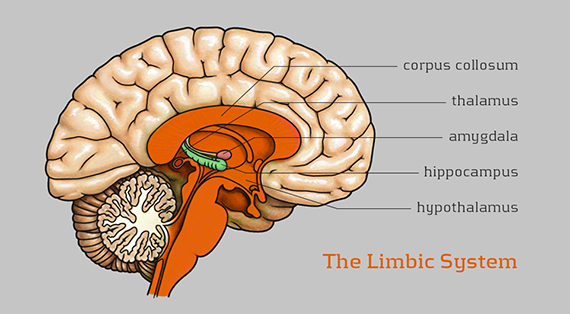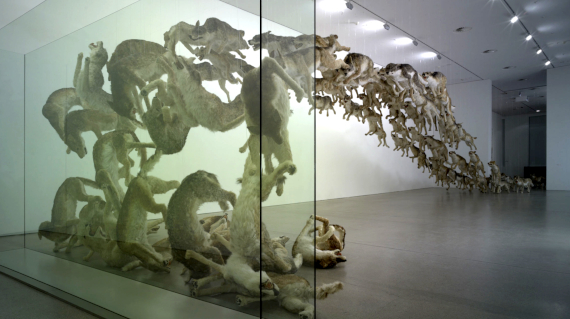 – The Human Brain ⋅ Primal instincts –
– The Human Brain ⋅ Primal instincts –
With the six sensory aggregates, the perception of our feelings arises through contact with reality. These sensory gates include eyes for contact with objects, ears for contact with sound, nose for contact with smell, mouth for contact with taste, body for contact with sensations/feelings, and consciousness for contact with thought.
These stimuli in the hypothalamus cause the development of our five primal drives: The first survival instinct stimulates food intake, which satisfies the second self-preservation instinct in the limbic system. The evolutionary drives of third sexuality, fourth fear and fifth violence stimulates the essence of our emerging personality. [1]
The survival and self-preservation instinct, in its interaction with the fear instinct, causes a direct impulse of security or threat. Security tends towards sexuality; threats lead to escape or aggression. Alcoholism, drugs or harmful sense foods cause disinhibiting behavior and subconscious conditioning to violence in the mesolimbic system.

– Melanin concentrating hormone and orexin –
In addition, the limbic system (hypothalamus) regulates the necessary processes that keep the organism alive. This includes the control of “breathing, circulation, body temperature, food digestion, sleeping and waking as well as consciousness and reaction state.” [2] The resulting behavioristic reactions in copulatory behavior, caring for ourselves and our closest relatives result in defence or attack against threats in territorial behavior, stress reactions against burdens and food supply.
There are four types of food that contribute to change in the limbic system: edible food, sense food, action intentions and consciousness. [3] When watching a film, the contact in the visual and auditory nerves stimulates the constitution of our primal instincts. The limbic system acts like a matrix of perception; in the stream of these influences, the matrix selects between pleasant, neutral and unpleasant feelings. Unpleasant stimulation of parts of the hypothalamus causes anger. Parts of the amygdala cause unpleasant fear. Parts of the mesolimbic system cause pleasant pleasure. The interaction of emotions can have lasting effects and cause mental illnesses in self-esteem.
Self-test: For example, in collectivism, watch martial arts, a boxing match, or an aggressive football game (please do not take disinhibiting drugs such as alcohol or chemical substances). Rate your feelings on a scale from 0 (absolutely unbearable) to 10 (very pleasant). If the value is below 3, it is better to stop the self-test (you are probably a very empathetic person who has good access to your feelings). If the value is above 5, your emotional state causes a narrowed consciousness, the development of selflessness or ignorance. This conditions coldness, egoism, ruthlessness or indifference. You can remember this in the theorem: competition create war between families. [4]
In selfless people, the organism simulates the state of emotions by rewarding itself and releasing dopamine. The messenger of the reward system in the brain, dopamine is released when, for example, long-sought goals are achieved and a desire or the prospect of reward motivates us to take an action.
The man in the essence of the woman
According to evolutionary biology, it is practical if the male embryo in the womb initially forms in the same way as the female. By the tenth week of pregnancy, the embryo grows into a bisexual hermaphrodite. The nipples develop very early in the embryo, before the sexual organs arise. The influence of testosterone creates the penis and testicles in the male embryo; Without the influence of testosterone, the clitoris and labia develops in the female embryo. Puberty and sex hormone Estradiol lead to the full development of the breasts and mammary glands in the growing woman. Theoretically, the stimulus of breastfeeding on the nipple could also stimulate milk production in men. Of course, a man’s milk production is not enough to cover the needs of an embryo. [5]
Fear processing
Fear arises as a mental formation in the brain area of the amygdala of the limbic system. As emotional beings, we view fear as a state of anticipated danger. The basic fears of humans include fear of change, fear of finality, fear of closeness and fear of becoming oneself. [6] An irrational fear is called a phobia. In our psyche and in the amygdala region, the perception of a threat differentiates and judges pleasant, neutral and unpleasant feelings.
Fear causes physiological changes in people that can cause behavioral responses such as: e.g. an aggressive reaction, freezing or fainting. If the stimulus represents a threat, information goes to the brainstem and prefrontal cortex, where the mental formation of our feelings is perceived. For millions of years, our protective and survival mechanisms have been taking vital counter-reactions in our genes by confronting fear or trying to escape it.
In political power development and ancient religions, fear was often used as a system of oppression. The enslavement of our human family has been maintained for millennia by power, oppression, brutal violence and fear. The Romans spread fear and terror against any resistance to the imperial system and displayed the inhumane sadistic crucifixion. The church terrorized with intimidating inquisition, gruesome witch burnings, and torture that forced every accused to confess. Nazis understood fear as intimidation with Holocaust and genocide of their racial ideology and destroyed all resistance of charity.
Gods, dictators, despots, tyrants, flags and kings of fear, damnation and revenge have probably only been known since the emergence of great civilizations. The rulers obviously needed this terror to ensure their demands and the obedience of their subordinates; fear and punishment are the most effective means of enforcing obedience.
Aggression and violence
The instinct for violence has a deeply rooted history in the limbic system. In snowy regions without plants, Homo sapiens have relied on violence to find food for the last 200,000 years. [7] Aggression and violence is the use of physical force to injure or kill living beings, in this process the drive also unleashes pain, injury, death, damage or destruction. The aggressive instinct is at an evolutionary level of permanent development and can be stimulated in many areas through its constructive stimulation. Rival competition, ruthless profit-seeking, inflammatory politics, hateful militarism or police operations, aggressive sports, brutal films, disinhibiting games, escalating groups or hard drugs and their side effects cause the greatest changes in the limbic system.
Most studies on violence and aggression have found testosterone to be linked to delinquency, violent crime, and alcoholism. A woman’s body only produces a small proportion of testosterone; larger amounts would have devastating effects on the female genitals and their ability to function. In most species, masculine creatures are more aggressive than feminine ones. [8] Any perception that turns into a reaction of violence affects the brain. Two areas in the cerebrum are activated, the putamen and the insular cortex. With the impulse from the putamen, an assessment is made in the brain in order to attack or flee. Our senses activate unsettling stimuli in the insular cortex, causing an action to take place from both areas through the hypothalamus.

– Cai Guo-Qiang ⋅ Head On ⋅ 2006 –
War is the worst form of violence. Numerous experiments prove that people can be easily and quickly driven to violence during militarism. Obedience gives rise to a lack of empathy in collective soldiering. Every reckless action by the soldier has far-reaching consequences that permanently affect the mesolimbic system in the brain. These stimuli reduce human empathic feelings and release the neurotransmitter dopamine. For many people, this state appears as if they have sensations that act like a drug and appear simulated emotions.
The atomic bombings of Hiroshima and Nagasaki on civilians were the most brutal attacks on the human family to date; 100,000 people died immediately and another 30,000 people died as a result. [9] This action by the USA forced Japan to surrender and ended the cruelest war in human history on September 2, 1945. As a result of the aggressive German Wehrmacht, 3 percent of the entire world population died (70-85 million people on the planet Earth, 1940). [10] Besides humans, there are only poisonous state-building ants that carry out hateful wars or resulting enslavement.
The capacity of morality /or/ Meta eternity
Perception is the most important link between our senses. Through contact with reality, mental formations arise that stimulate the human brain. Our memories form a symbiosis with these mental vessels and realize feelings in them. [11] As a companion in our self-esteem, the attachment of emotions consolidates us until death. People use the security gained from this to increase their self-worth or to reduce it through selflessness – one man’s rejoicing is another man’s failure. [12]
Listen, there is an image on agora market, it’s possible to recognise three pieces: First the ego, as the strongest image for fair trade, unfortunately this image has a side effect to create profit or it will cheat the mathematics game. The second image is created in the capacity of consciousness as our ideology in signs or glyphs: finally in the concentration of numbers. The third image will appear in hands, if the market is broken.
The more security an individual builds, the perception more improves. This creates interdependence with which nature stimulates a flowing change in the entire life in balance. The feeling of threat has the greatest metamorphosis. In contrast, security creates an impulse of refuge, and nature influences the changes in the DNA from this. Living beings adapt to the environment and begin to merge with it. In the transformation there is also a correction of the change. Nature will find a way. [13]
In the military, for example, soldiers beyond nature wear their spotted camouflage pattern uniforms as an attachment of superiority, in this structure of servant emotions processes, self-perception destroys its own enemy image. What psychology is really in there? When a civilian looks at a soldier, the image of a hierarchy with symbols appears. The only difference between militarism is the uniform, the ethnicity inside is just another parable of nature. [14]
The symbols on the uniform serve as a kind of signpost to violence, just like at a train station, docks or airport the pictograms to the gate, exit or toilet describe the route. What is crucial is the perception of a weapon that the soldier embodies as an attachment to violence. The weapon wielder already has hate within him, the attachment to his being is just another bound transformation to unleash the weapon in a process of hatred. In a simliar prime progress, our fear formation use morphology to change into morality. [15]
Just as humans have received sensory aggregates from nature and form existence with the reality of their food, nature also forms existence with humans. The metamorphosis of nature looks into its creation and influences the structures of our perception. Human senses (eyes, ears, nose, mouth, feeling and thinking) only capture the degree of nature, thus, for example, we see with our eyes in the spectrum of light a transformation that is determined for our greatest perception. With technologies such as night vision, infrared, radar, sonar and nuclear weapons, people are trying to leave this spectrum; the result succumbs to the high level of threat or the cemetery ⋅ སེམས གཟིགས







